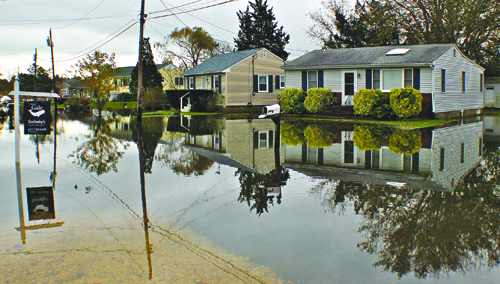Dealing with Sandy’s salted earth

Right after Hurricane Sandy, cleaning up the damage may have seemed straightforward.
Cut up that tree that uprooted in the backyard after the storm tide weakened the roots. Call an electrician to have the service put back on and wait for LIPA to hook it up at the street. Fret and wait for the insurance company to call and say how much your out-of-pocket cost will be.
The storm is long gone, but for some, lawns have turned an unnatural shade of gray. The few remaining leaves on the boxwoods have turned black, and all the landscaping has taken on a ghostly hue.
It could just be the start of winter, but if a property was under water for any time during the storm, chances are salt saturation is to blame.
Cornell Cooperative Extension turf specialist Tamson Yeh says there may still be time this year to save home landscaping from permanent salt damage.
“Make sure your yards are well-watered,” she said. “It’s going to be warm this week, which will be a good time to do hand watering of trees and shrubs to leach the salt away from the roots. Or turn on the irrigation, if it hasn’t been drained for the season, for an inch every other day to flush out the salt in the soil.”
Cutchogue landscape designer Judy Plant, who has been working with seaside properties for more than 20 years, swears by the use of powdered gypsum soil amendment, which is spread over the soil or can be dug into bare ground. The calcium-rich gypsum helps leach salt from garden soils.
Ms. Plant remembers one garden she put in at Sterling Harbor Marina in Greenport before a hurricane.
“The water just laid on the gardens I’d planted there, for several days at a time,” she said. “I put gypsum all over and nothing died. I’ve used it in so many cases. I’ve used it for breaking up clay at Port of Egypt. It’s a product that does many things.”
Ms. Plant said she tends to plant species that will do well by the seaside in gardens that might be flooded or exposed to salt spray.
The good news, she said, is that many, many plants do well by the shore. She said hydrangeas and rugosa roses of all kinds thrive there, as do many ornamental grasses. She’s also had good luck with Montauk daisies, butterfly bushes, lilacs, lavender and creeping thyme. Larger spirea bushes and rose of Sharon make good tall hedges for windbreaks. Ms. Plant is especially fond of spirea, deciduous shrubs that flower throughout the spring and summer.
“It has incredible foliage colors and pink flowers. It can withstand almost anything,” she said. “It’s a sun-lover.”
In most autumns, new plantings can be added until mid-November, so there is still a very small window of time this year to plant new bushes that will bloom next year. But Ms. Plant cautioned that this season doesn’t seem to be following the norm weather-wise. Spring is also a good time to plant new landscaping. Ms. Yeh shares Ms. Plant’s assessment of the best seaside plantings. “Lilacs are fairly salt tolerant, as are ornamental grasses,” she said.
“Many roses are fairly salt tolerant.” Ms. Yeh said turf grasses also vary greatly in their tolerance of salt water — tall fescues are the most tolerant, while Kentucky bluegrass is the least.
The Long Island Cauliflower Association in Riverhead also recommends for seaside lawns creeping bentgrass, seashore paspalum, Bermuda grass and Zoysia grass.
Ms. Yeh said the best way to tell whether your grass has survived or the lawn has been permanently damaged by salt water is to cut out a small piece of turf, put it in a pot in the house and treat it like a houseplant during the winter. If the root system has survived, new green shoots should begin popping out of the soil within a few weeks. She isn’t a huge fan of adding lime or gypsum to the soil to balance out the acidity created by the salt water.
She believes those amendments don’t work as well in Long Island soil as they do elsewhere in the country.
“You can lime. It’s not going to hurt anything unless the pH is already high, but it’s probably not going to do a lot to ameliorate salt damage,” she said. “Gypsum’s best effect is on soils that are different than Long Island soils. [Long Island] soils’ best friend is going to be water, water, water. Try to push the sodium away from the plants.”
She also recommends rinsing off and hosing down plants that were exposed only to salt spray, not to flood waters.
Gardeners concerned about salinity levels in the soil can call the extension office at 727-7850 for advice on sending soil to be tested.
Ms. Yeh also recommended a simple test for soil salinity that gardeners can do at home. “Take some of your soil, after you’ve leached it, and put in some tomato or cucumber seeds. If they don’t grow, or if they get to the two-leaf stage and collapse, you still have salt in the soil,” she said.








